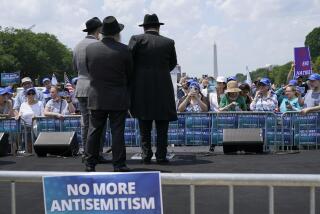Anti-Muslim Bias Is Rising, Survey Finds
- Share via
WASHINGTON — Deciding to don the hijab, the head scarf worn by traditional Muslim women, was a difficult decision, says Anjum Smith. A member of a USAir ground crew in Richmond, Va., and the only Muslim member of the staff, she held the job for more than five years before summoning the courage to wear the hijab at work.
“I was afraid of ridicule,” she said.
Two and a half years later, her fears were realized when a new boss wrote a letter demanding that she take off the hijab. “At the time, I just couldn’t do that,” Smith said. “It was incomprehensible.”
Smith contacted the American Civil Liberties Union, the Virginia attorney general, and the Equal Employment Opportunity Commission before USAir backed down, saying that as long as she remained a utility worker, she could wear the hijab.
Although Smith won her battle, such instances of discrimination appear to be on the rise as the nation’s Muslim population grows, according to the Council on American-Islamic Relations, which featured Smith at a press conference this week to release its annual report on incidents of discrimination.
The Washington-based organization, which monitors incidents against Muslims and seeks to promote a more positive image of Islam in the United States, says incidents of discrimination have risen by 67% since last year.
The group concedes, however, that the apparent rise may result as much from changes in reporting as from any spurt of American xenophobia. This is only the third year the council has published its report, and “disparities in reporting patterns at this early stage of inquiry are to be expected,” the report cautions.
While the group claims an increase in overall incidents of discrimination--a category that includes events in the workplace, police misconduct and court bias--incidents of harassment and violence against Muslims have declined.
*
Cases of physical violence reported to the organization fell from 19 in the period of March 1996 through March 1997 to 12 reported from March 1997 through March 1998. Reports of harassment plummeted from 66 to 24 cases in the same period.
In the more general category of discrimination, incidents rose from 98 in the 1996-97 period to 148 in the most recent year.
California had the second-highest percentage of reported incidents of discrimination, rising in this dubious ranking from its sixth place in last year’s report.
“The struggle against discrimination has become an integral part of Muslim daily life in America,” said Mohamed Nimer, the council’s director of research.
“Anti-Muslim incidents no longer represent passing episodes in times of crisis,” the council’s report asserts. “Ethnic and religious bias is expressed not only in situations of conflict, but also in ordinary life circumstances.”
One frequent target of complaint by Muslim activists has been the Federal Aviation Administration’s passenger profiling program, which has been accused of unfairly targeting Arabs and other Muslims for special scrutiny.
“There is a reason to suspect that Muslim religious and ethnic characteristics may trigger increased security under the procedure,” the report said.
The greatest number of complaints, however, involve charges of discrimination on the job. In many cases, the group says, Muslims have been targeted for visible signs of their faith or ethnicity, such as wearing a hijab or speaking with an accent.
*
In one case cited in the report, a company in Falls Church, Va., fired an employee on his first day of work for wearing a long white shirt, pants, and a kufi, or traditional cap.
“Muslim community members have been showing progress in how to deal with these incidents,” said the council’s executive director, Nihad Awad. “They know how to defend their rights.”
In many cases, he added, “we find that ignorance has been a main factor,” in anti-Muslim incidents.
“We’ve been fairly successful once we go to a company,” Communications Director Ibrahim Hooper said. “The bigger a company is, the easier it is to resolve a case.” When informed of an instance of discrimination, the council will typically write to the chief executive of the company with the allegations and news articles relevant to the issue.
“In many cases, that’s the end of it,” Hooper said.
That may not be true for Anjum Smith, however. Recently furloughed, she said she may seek another position outside of the utility classification, where USAir has not sanctioned her wearing a hijab. “If I transfer to another location, all bets are off,” she said.
But Smith showed no signs of backing down. If USAir bars her from wearing the hijab again, she said, “this time maybe I will sue them.”
More to Read
Sign up for Essential California
The most important California stories and recommendations in your inbox every morning.
You may occasionally receive promotional content from the Los Angeles Times.











